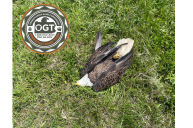A bald eagle was shot and killed in Alabama, and authorities are determined to find the culprit.
According to Whiskey Riff, Alabama's bald eagle population was almost entirely decimated in the 1960s. After decades of concerted conservation efforts, the population of the birds in Alabama in now strong. Still, even after a remarkable recovery, Alabama is not a state with a massive bald eagle population. Today, the state is home to over 200 known nesting pairs of bald eagles. Bald eagles are found all over the state, and especially along large bodies of water. Alabama's Lake Wheeler, Tennessee River and Lake Guntersville are all great places to spot bald eagles in Alabama.
While the story of bald eagles in Alabama is mostly a great one, a few bad actors can leave a sour taste in everyone's mouth from time to time. According to the United States Fish and Wildlife Service, a deceased bald eagle was found in Lawrence County, Alabama last month. The deceased eagle was discovered near Mt. Hood, and X-rays determined that a shotgun had been used to kill the beautiful bird.
Now, the US Fish and Wildlife Service is offering a reward for any information that can help in finding, and convicting, the killer. Notably, it is perhaps possible that a hunter confused the bird for a duck or goose, and made an honest mistake. Such a story seems incredibly unlikely. Moreover, it really is not an acceptable answer. Correctly identifying a target is always necessary before firing any weapon.
Authorities Offer Reward In Effort To Identify Who Killed A Bald Eagle In Alabama
Bald eagles have been a protected animal throughout the United States for decades. Such conservation efforts have been instrumental in the continued development of the strong population of the species throughout the country.
Officially, it was 1967 when bald eagles were first included on the Endangered Species List. Forty years later, in 2007, bald eagles were removed from the list. It is noteworthy though, that the species is still federally protected. The Bald and Golden Eagle Protection Act, and the Migratory Bird Treaty Act, protect the species across the United States.




